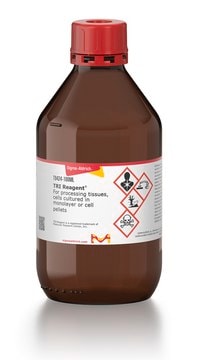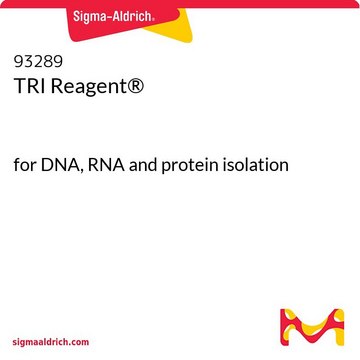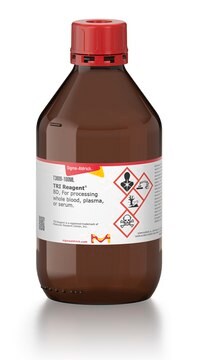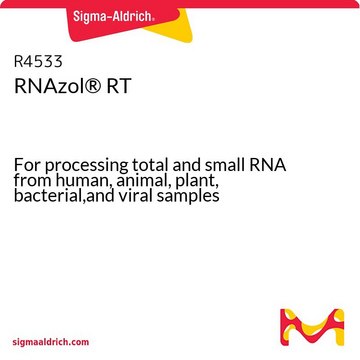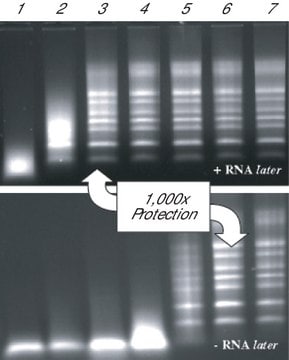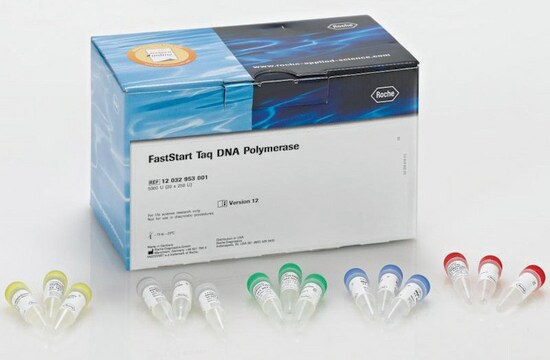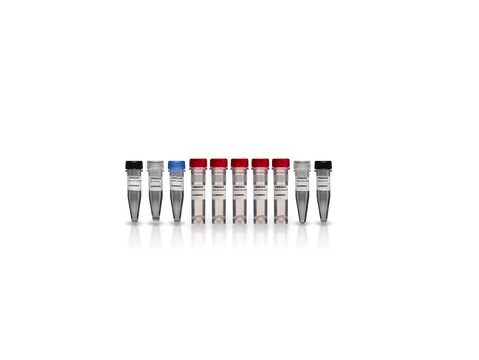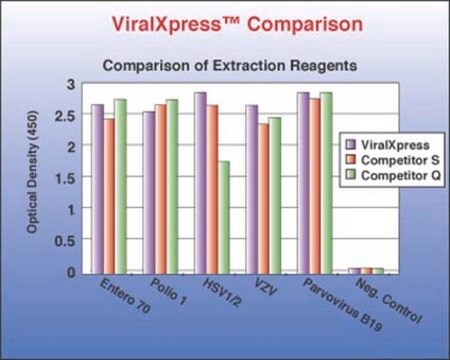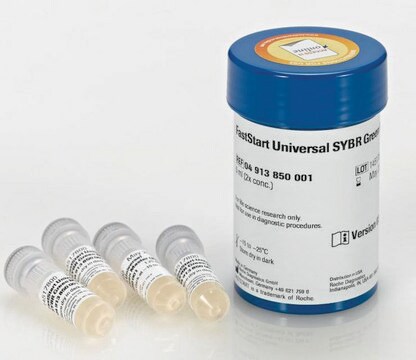T3934
TRI reagent®
LS, For processing fluid samples such as cell suspensions, CSF, and amniotic fluid.
Sinonimo/i:
TRI Reagent® reagente per l’isolamento dell’RNA
About This Item
Prodotti consigliati
Livello qualitativo
impiego
0.75 mL sufficient for 0.25 mL fluid samples
Cerchi prodotti simili? Visita Guida al confronto tra prodotti
Descrizione generale
A convenient single-step liquid phase separation results in the simultaneous isolation of RNA, DNA, and protein. This procedure is an adaptation of the singlestep method reported by Chomczynski and Sacchi for total RNA isolation, and permits fast and efficient processing of liquid samples. TRI Reagent LS performs well with large or small sample volumes, and many samples can be simultaneously extracted.
TRI Reagent LS is a mixture of guanidine thiocyanate and phenol in a monophase solution. When a biological sample is homogenized or lysed with it, and chloroform or 1-bromo-3-chloropropane is added, the mixture separates into 3 phases: an aqueous phase containing RNA, the interphase containing DNA, and an organic phase containing proteins. Each component can then be isolated after separating the phases. 0.75 ml of TRI Reagent LS processes 0.25 ml of a liquid sample such as amniotic fluid.
This is one of the most effective methods for isolating total RNA from fresh samples in only one hour. The procedure is very effective for isolating RNA molecules of all types from 0.1-15 kb in length. The resulting RNA is intact with little or no contaminating DNA and protein.
Applicazioni
Caratteristiche e vantaggi
- Isolamento dell'RNA facilmente scalabile
- Funziona con campioni di diversa origine: umana, vegetale, di lievito, batterica o virale
- Ha una resa migliore rispetto ai tradizionali metodi guanidina tiocianato/cloruro di cesio
Note legali
Prodotti correlati
Avvertenze
Danger
Indicazioni di pericolo
Classi di pericolo
Acute Tox. 3 Dermal - Acute Tox. 3 Inhalation - Acute Tox. 3 Oral - Aquatic Chronic 2 - Eye Dam. 1 - Muta. 2 - Skin Corr. 1B - STOT RE 2
Organi bersaglio
Nervous system,Kidney,Liver,Skin
Rischi supp
Codice della classe di stoccaggio
6.1A - Combustible acute toxic Cat. 1 and 2 / very toxic hazardous materials
Classe di pericolosità dell'acqua (WGK)
WGK 3
Punto d’infiammabilità (°F)
174.2 °F - closed cup
Punto d’infiammabilità (°C)
79 °C - closed cup
Scegli una delle versioni più recenti:
Possiedi già questo prodotto?
I documenti relativi ai prodotti acquistati recentemente sono disponibili nell’Archivio dei documenti.
I clienti hanno visto anche
Articoli
The availability of simple methods for purification of DNA and RNA has greatly facilitated the analysis and characterization of the genome and gene expression. There is a demand to isolate DNA and RNA rapidly and conveniently from a variety of cellular sources, including cells and tissues from mammalian, plant and bacterial cultures.
Il team dei nostri ricercatori vanta grande esperienza in tutte le aree della ricerca quali Life Science, scienza dei materiali, sintesi chimica, cromatografia, discipline analitiche, ecc..
Contatta l'Assistenza Tecnica.